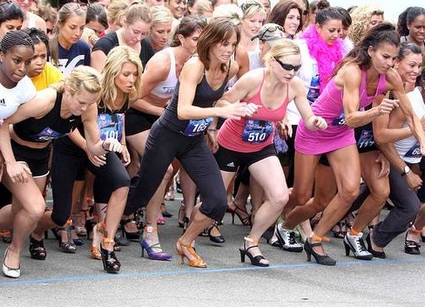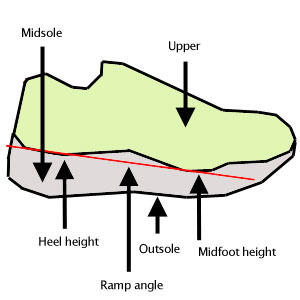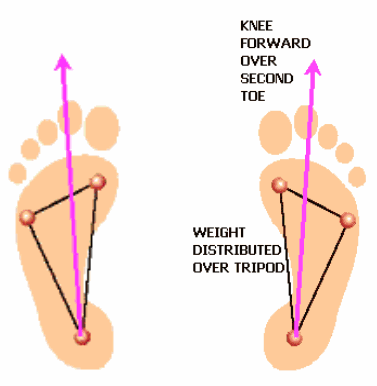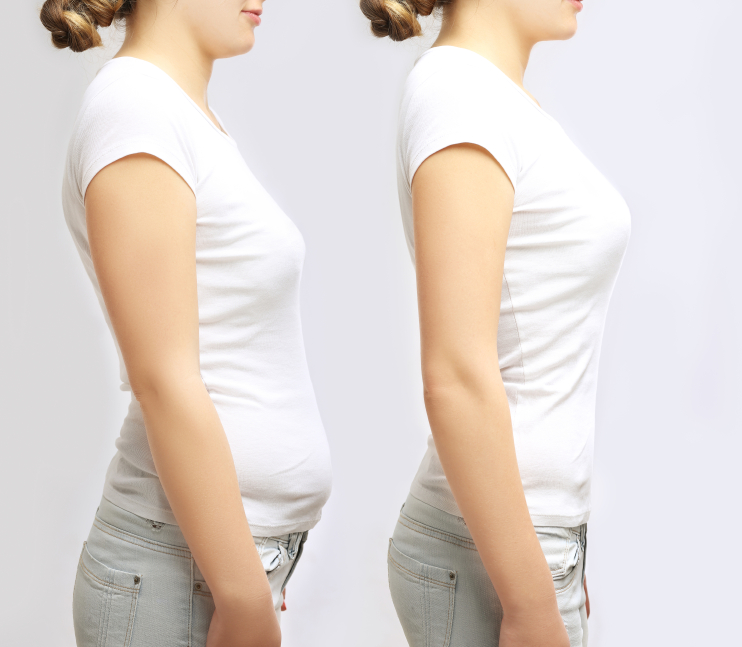Shoe Flaw #2: The Elevated Heel
 The vast majority of casual AND training shoes on the market are not designed to allow our foot to function optimally – even though they may be marketed as such.
The vast majority of casual AND training shoes on the market are not designed to allow our foot to function optimally – even though they may be marketed as such.
Let's take a look at the average running shoe, a shoe that most people think are comfortable and therefore must be good – or at least “not bad” - for our feet. Here are some typical features:
- A tapered toe box – to squeeze your toes together and prevent them from splaying naturally.
- An elevated heel – that subtly shifts our body mass forward and causes our entire body to react to this shift by compensating. Knee pain anyone? Additionally, our lower leg muscles can never fully lengthen. How about tight calves? Foot cramps?
- A toe spring – this causes the toes to bend upwards.
- Lots of cushioning – to reduce your awareness of the ground and cause you to overstride, no doubt.
- Too much stiffness in the sole – which prevents one of the most mobile parts of our body from experiencing movement.
The totality of these characteristics creates a ton of issues as we age and ignorantly wear our ill-fitting shoes all day, every day. So to that end, I'd like to bring more awareness as to what to look for when choosing a shoe so you can, at the very least, make a more informed decision.
Today I want to dig into #2 on the list, the elevated heel, and there's a few reasons this is so problematic.
One of my mentors, Charlie Weingroff, put it best when he said, “the elevated heel is the bane of all human movement.” Ouch! Pretty harsh words, right?
What's so bad about an elevated heel? And what exactly do I mean by an 'elevated heel'?
Fashion, Not Function
Wearing a shoe that elevates your heel above the ball of your foot is unnatural. Period. If there was some functional advantage to an elevated heel, don't you think our heels would be bigger or built up by now? Well, there isn't.
The elevated heel was invented for two reasons (that I can think of). The major reason is fashion. Legs look better, we get taller, and we feel better about ourselves. Nearly all dress and most casual shoes have elevated heels.
And, of course,  conventional running shoes have an elevated heel. This began in the 1970s. It was thought that if you elevated the heel of a running shoe, you'd reduce the incidence of achilles' tendon problems.
conventional running shoes have an elevated heel. This began in the 1970s. It was thought that if you elevated the heel of a running shoe, you'd reduce the incidence of achilles' tendon problems.
Unfortunately, that one simple change to the running shoe has led to a whole host of other problems which I've either already covered or will in the future.
See, our body functions best when the heel is on the same level as our forefoot. Our posture is closer to ideal and our movements are better. Here are a few examples.
Posture Changes
When standing while wearing an elevated heel, your center of mass is shifted slightly forward. Although this positional shift is small, it has large consequences for your entire body.  Starting at the feet, your weight shifts towards the forefoot. This reduces overall stability because now, instead of owning a tripod of pressure evenly distributed on your heel, inner and outer forefoot, you have taken some pressure off the heel.
Starting at the feet, your weight shifts towards the forefoot. This reduces overall stability because now, instead of owning a tripod of pressure evenly distributed on your heel, inner and outer forefoot, you have taken some pressure off the heel.
The calves and front of the knees get overloaded due to this shift, too. This is because they are turned on all day, preventing you from falling forward. Try walking up steps by pushing through the toes versus evenly through your whole foot. Which feels better on the knees? Whole foot, no doubt.
Next, your pelvis will rotate anteriorly which means your hip flexors shorten and your low back arches excessively. This leads to overactive low back muscles and inhibited, weak abdominal muscles. There's even some talk about what shifting your pelvis like this does to your internal organs (google: visceroptosis) though I'm not sure I'm ready to be that dramatic.
which means your hip flexors shorten and your low back arches excessively. This leads to overactive low back muscles and inhibited, weak abdominal muscles. There's even some talk about what shifting your pelvis like this does to your internal organs (google: visceroptosis) though I'm not sure I'm ready to be that dramatic.
Oh, and if your hip flexors and low back get tight while your abdominals become inhibited, you can practically kiss your butt muscles bye-bye! Don't get me started on that ;-)
Movement Gets Ugly
One obvious example of how we acquire movement dysfunction shows up in the deep squat pattern. When we wear shoes with an elevated heel we gradually lose the ability to shift our weight posteriorly. Since the shoes unnaturally shift our weight forward, we actually learn how to move in that unnatural way. What do you think will happen to your body over many years if you move it in unnatural ways?
I can't tell you how many new clients cannot perform a simple hip hinge and push their hips backwards appropriately into a low squat. Why? Two reasons. Obviously if you don't use it, you lose it. The deep squat is a simple and very beneficial resting position, yet we are more familiar with the chair. With so many nice chairs available, why would we squat?
Secondly, if you wear shoes with an elevated heel you shut down your glute muscles and eventually they just 'forget' how to stabilize the body properly. Its a coordination thing. This is why, when attempting to re-pattern a deep squat, I'll provide my clients with a heel lift. Then I'll gradually give less and less lift until they're squatting deep without the lift.
The bottom line is that whether you squat, lunge, balance on one foot or just stand still looking at yourself in the mirror while doing a bicep curl, getting your heels closer to the ground is smart.
My Philosophy
It's simple. First, if you don't already, start walking around your house barefoot. Next, wear the best looking, yet least amount of shoe that works for you. Let's get the shoe out of the way of your foot and put some trust in our amazing feet. There seems to be this assumption that our feet are inherently flawed and we need all sorts of support and cushioning to coddle our feet. Yet, in other cultures that do not have our fancy shoes, we don't see the same podiatric and orthopedic issues. Protect your feet, but allow your feet to function as the incredible sensory organs that they are.
**PS: If you're currently dealing with a foot problem, see an expert for an evaluation. Ok? Good.**
*Updated January 4, 2016. Originally published on July 24, 2012

